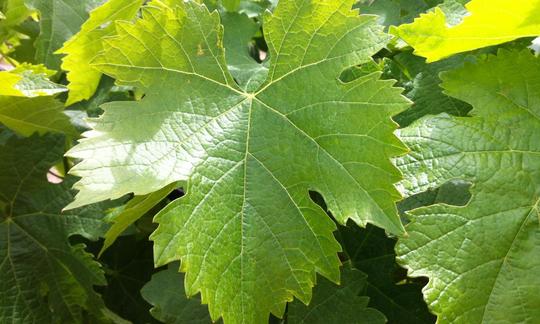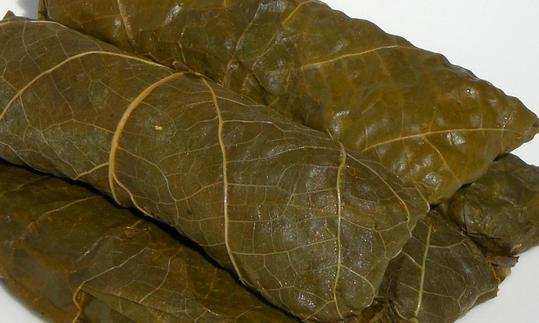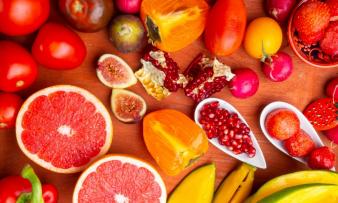Table of contents
Grape leaves ( Vitis vinifera) are popular in Turkish, Greek and oriental cuisine. Organic grape leaves are rarely available in stores, they are mainly available in online shops. Raw grape leaves are purchased directly from the farm or from home cultivation.
Use in the kitchen
Vine leaves are mainly used to make roulades. The leaves have a neutral taste and remain compact even when cooked. Stuffed vine leaves are a popular Mediterranean appetizer. They are known as dolma, sarma or dolmades, among other things.
Stuffed vine leaves can be prepared with various fillings. Traditionally, rice, raisins, onions, herbs ( parsley, dill, mint) and pine nuts are used. The rice is usually boiled before being wrapped. However, you can also add it to the filling after it has been boiled briefly, cover it and simmer the stuffed vine leaves in water or vegetable stock for 40-50 minutes on a low heat. Delicious alternatives to rice are red lentils, spelt, bulgur and quinoa. You can also use vine leaves as a substitute for savoy cabbage and try out common fillings for cabbage rolls.
Which vine leaves should you use for stuffed vine leaves? For pickled vine leaves, you should use young, light green leaves that are about the size of your hand. If you use fresh leaves, you should blanch them briefly in water. The vine leaves are often preserved in brine. These should be placed in water before consumption and rinsed thoroughly so that some of the salt can be removed.
Fresh, young vine leaves also taste good as a raw salad, for example with cucumbers, tomatoes and black olives.
Vegan recipe for stuffed vine leaves
Ingredients (for approx. 40-50 pieces): 300 g vine leaves, 250 g medium-grain wholemeal rice (risotto rice), 750 ml low-salt vegetable stock, optionally 200 ml white table wine, 4 medium-sized onions, 2-3 cloves of garlic, 40 g raisins, 40 g pine nuts, 1 tbsp rapeseed oil, 2 organic lemons, a handful of fresh herbs ( mint, parsley, dill), salt,black pepper.
Preparation: Vine leaves pickled in brine should be soaked in water for half an hour and then rinsed thoroughly. Blanch fresh vine leaves in boiling water for 1-2 minutes before use. Then drain the vine leaves well, remove the stems if necessary and carefully pat dry with a clean tea towel.
Peel and finely chop the onions and garlic. Carefully scrape the lemon peel with a grater. Then halve the lemon and squeeze out the juice. Put oil in a pan and sauté the onions and garlic until translucent, add the rice and fry for a few minutes while stirring. Add the raisins, pine nuts, lemon juice and lemon zest. Add around 500 ml of the vegetable stock, bring to the boil and then simmer on a low heat for 5-10 minutes until the liquid has been absorbed. Add fresh herbs and season with salt and pepper. Allow the filling to cool slightly.
Line a second pot with one or two layers of vine leaves. Use the small or damaged vine leaves for this. Cut the second lemon into slices and place on the vine leaves.
Lay out the vine leaves on a work surface with the tip facing upwards. Place 1 teaspoon of the filling above the base of the stalk. First fold the lower part of the vine leaf upwards over the filling, then fold in the side edges one after the other and roll the filling up tightly towards the tip of the leaf. Place the stuffed vine leaves tightly packed in the pan lined with the vine leaves and lemon slices. Then add the vegetable stock and the white wine so that the vine leaves are all well covered with liquid. Bring the liquid to the boil and then simmer on a low heat for approx. 40-50 minutes. Remove the stuffed vine leaves from the pan and serve warm or cold.
Making tea with vine leaves
Ripe, red vine leaves are usually used to make tea instead of young, green vine leaves. Chop dried or fresh vine leaves into small pieces, pour boiling water over them and let them steep for about 6-10 minutes.
Vegan recipes with vine leaves can be found under the note: " Recipes that have the most of this ingredient ".
| Not only vegans or vegetarians should read this: Vegans often eat unhealthily. Avoidable nutritional errors. |
Purchasing - Storage
Large retailers such as Coop, Migros, Denner, Volg, Spar, Aldi, Lidl, Rewe, Edeka, Hofer, Billa do not stock vine leaves (fresh or pickled in salt water) as part of their standard range. Organic supermarkets such as Denn's Biomarkt and Alnatura do not stock them either. You can occasionally find stuffed vine leaves in cans.
Vine leaves preserved in brine are more likely to be bought in shops selling Turkish or Greek food, delicatessens, gourmet shops (Globus) and online shops. Sometimes you can also find vine leaves packed in jars that have only been stored in water. Fresh vine leaves can occasionally be found seasonally at weekly markets or you can harvest them in your own garden. It is important that you use vine leaves from controlled organic cultivation or natural production, as these are not contaminated with pesticides.
The availability of vine leaves varies depending on the size of the store, catchment area, etc. Our recorded food prices for the DA-CH countries can be found above under the ingredient image - and by clicking you can see their development at various suppliers.
Storage tips
Vine leaves preserved in brine are available in cans, jars or sealed plastic packaging. If kept unopened, cool and protected from light, vine leaves can be stored until their best-before date (usually three to five years). Opened packaging should be kept in the refrigerator and consumed within 3-5 days. Stuffed vine leaves can be kept in a closed container in the refrigerator for a good 3 days.
Ingredients - Nutritional values - Calories
100 g of raw vine leaves (organic) contain 93 kcal of energy and are very rich in fiber (11 g/100g). The proportion of carbohydrates (17 g/100g) and proteins (5.6 g/100g) is low. They contain only a small amount of fat (2.1 g/100g). The unsaturated fatty acids have a good ratio of linoleic acid (LA) to alpha-linolenic acid (ALA) at 1:6. 1
Raw vine leaves are rich in vitamin A, as RAE. 100 g of vine leaves contain 1,376 µg. Also rich in vitamin A are carrots (835 μg), carrot juice (956 μg), sweet potatoes (709 μg), dried chili peppers (1324 μg) and dried goji berries (1341 μg). Sweet paprika powder (6042 μg), hot paprika powder (2463 μg) and chili powder (1483) contain a lot of provitamin A, but people usually only eat 1 g of it, which is why the content per portion is small. 1
Raw grape leaves contain 109 µg of vitamin K per 100 g. Vitamin K1 is found mainly in green vegetables and salads. Swiss chard (830 µg) and kale (705 µg) contain particularly high levels of it. 1
Manganese is also present in abundance at 2.9 mg/100g. This is found primarily in the germs and outer layers of grains. Larger amounts are found in wheat germ (13 mg/100g), wheat bran (12 mg/100g) and teff (9.2 mg/100g). 1
Do vine leaves contain a lot of salt? The salt content in raw vine leaves is low at 23 mg/100g. 1 However, the salt content in vine leaves preserved in brine is much higher. The salt content is always listed in the nutritional information for the product.
The complete ingredients of grape leaves, the coverage of the daily requirement and comparison values with other ingredients can be found in our nutrient tables. In the article Nutrients explained you will get a detailed insight into the topic.
Health effects
Grape leaves, like the skin and seeds of grapes, contain a high content of bioactive substances such as phenolic compounds, α-tocopherol (vitamin E), carotenoids, flavonoids and polyphenols. 11,12,13,14
Young, light green leaves are mainly used for dishes. Studies on vine leaves from Italy show that the total content of phenolic compounds changes as the leaves grow, but the antioxidant effect remains relatively stable at a high level. The vine leaves between July and September have higher levels of phenolic compounds than those in October. 12 A study from Turkey shows the influence of different preservation methods on the content of phenols and flavonoids. It turned out that vine leaves that were tightly packed in a screw-top jar without brine had the highest content. The vine leaves preserved in brine had a higher content than frozen vine leaves. 14 A similar study from Israel produced contradictory results. Here, frozen vine leaves had a higher content of phenols and flavonoids than those preserved in brine. The highest values were found in fresh vine leaves. 13
Ripe, red vine leaves are used as a medicinal plant for venous disorders, heavy legs or circulatory disorders (see Use as a recognized medicinal plant below). An observational study with a vine leaf preparation available on the market tested the effect of red vine leaves on patients with chronic venous insufficiency (CVI). After two weeks of taking the venous capsules daily, pain and tension decreased. The edema on the legs and the volume of the patients' calves also decreased significantly. 4
Dangers - Intolerances - Side effects
The vine leaves are obtained from vines that are grown for the production of wine or table grapes. Since pesticides are usually used in commercial cultivation, corresponding residues are also found on vine leaves.
Investigations by the CVUA Stuttgart on grape leaves (in brine) for pesticide residues from 2015 to 2020 show that values above the legally specified maximum levels were repeatedly detected. Grape leaves from Egypt, Turkey, Bulgaria and Greece were contaminated. 5 Öko-Test also reported in 2023 that several of the products they examined contained pesticides above the limit. However, 11 products were also found whose pesticide residues were not objectionable, including the only two organic products in the test. 6
It is therefore essential to buy vine leaves from organic farming (with a seal of approval).
Use as a recognized medicinal plant
Ripe, red vine leaves are used to use vine leaves as a medicinal plant. The Committee for Herbal Medicinal Products (HPMC) of the European Medicines Agency (EMA) classifies the use of dried vine leaves in defined extracts or in tablet form as "well-established use". The HPMC, on the other hand, classifies the crushed or powdered leaves as tea or in semi-solid medicinal forms for application to the skin as traditional herbal medicines. Indications for extracts include use in the treatment of chronic venous insufficiency, which is characterized by swollen legs, varicose veins, heaviness, pain, fatigue, itching, tension and cramps in the calves. 8
The EMA classifies the use of vine leaf preparations for mild circulatory disorders, haemorrhoids and fragility of the skin capillaries as "traditional use". This means that despite insufficient evidence from clinical studies, the effectiveness of these herbal medicines is plausible and there is evidence that they have been used safely in this way for at least 30 years (including at least 15 years within the EU). 9
Ecological footprint - animal welfare
Grape leaves are obtained from vines that are grown for the production of wine or table grapes. Grape leaves are therefore only a by-product. Therefore, to our knowledge, there are no studies on the CO 2 footprint or water footprint specifically for grape leaves.
Studies on the CO 2 footprint always refer to the vines. According to a review study from 2022, the main factors for an increased CO 2 footprint are fuel (e.g. diesel), fertilizers and phytosanitary products (pesticides, etc.). The CO 2 footprint per kilogram of grapes is almost zero up to 0.85 kg CO 2 eq/kg grapes. 16
We were able to find an experimental study on grape leaves: Researchers examined the CO 2 footprint of grape leaves grown in greenhouses in hydroponic systems (instead of in soil in water with nutrient solution). This cultivation method came to 10.35-79.2 kg CO 2 eq/kg, depending on the specific method. 15
The ecological footprint of grapevines depends on the country of origin and the cultivation method. In countries that struggle with water shortages due to climatic conditions and rely on artificial irrigation to water the vines, this has a particularly strong impact on the ecological footprint.
The environmental impact of grape leaves can therefore be very small, comparable to fruit or vegetables, or they can cause problematically high footprints or environmental effects.
For detailed explanations of various sustainability indicators (such as ecological footprint, CO2 footprint, water footprint), see our article: What does the ecological footprint mean?
Animal welfare - species protection
Conventional viticulture is a particularly intensive form of agriculture and therefore a radical intervention in the ecosystem. The heavy use of pesticides also often leads to illnesses, such as Parkinson's. In some countries, Parkinson's is recognized as an official occupational disease in viticulture (see also the chapter 'Danger - Intolerances - Side effects' above).
Organic winegrowers strive to minimize environmental damage as much as possible. They try to promote soil organisms through organic farming, increase biodiversity (fauna and flora) in the wine-growing region, avoid using pollutants and thus treat the environment with care. 17
Worldwide occurrence - cultivation
The grapevine, Vitis vinifera, is a grape variety with its genetic center in the Middle East. It was further spread by the Phoenicians, Greeks and Romans in ancient times throughout the Mediterranean region. 2 The ancient Greeks and Romans in particular used the vine not only for viticulture, but also as a source of food. They began to breed new grape varieties, and viticulture also spread in Europe. In the 15th and 16th centuries, the grapevine came to America and finally to Latin America in the regions of Chile and Argentina. The main growing areas for table grapes in Europe today are Italy, Spain, Greece and Turkey. In the winter months, grapes are imported from South Africa or India. 3
Vine leaves sold in the DA-CH region (in brine and stuffed vine leaves) mainly come from Turkey, Greece, and sometimes Egypt and Bulgaria. 5,11 However, more and more products from China are also appearing on the market. 6 Greek companies sometimes buy Chinese vine leaves to process them further, as prices in Greece are rising. 7 The global market for vine leaves is very large, but international trade is still poorly developed. Vine leaves are usually consumed where they grow. However, due to globalization and worldwide migration, the consumption of vine leaves is steadily increasing and new sales markets are emerging, for example in Central Europe (Germany) and Russia. 10
Grape leaves that are light green and not yet fully ripe are used for preparing food. The ideal time to harvest them is before or during the flowering period of the grapevines (May to June). 11 However, the red-colored vine leaves in autumn are mainly used for the production of phytopharmaceuticals.
Information on the cultivation and harvesting of grapevines can be found under the link to the ingredient grapes (raw, organic?).
Industrial production
Fresh vine leaves can be stored for 4-8 weeks at 0 °C. They can be stored in the refrigerator at 0-5 °C for around a month. Although fresh vine leaves are preferred for cooking, they can only be harvested within a limited period of time when they are ideally ripe (May to early June) and they do not keep for long. This is why vine leaves are preserved so that they can also be eaten out of season. 11 Methods of preserving vine leaves include freezing, preserving in brine or storing in airtight, sealed glass containers. 13,14 The preserved vine leaves change their color from light green to a yellowish olive green. This is due to the conversion of chlorophyll to pheophytin. 11
After carefully sorting out any damaged leaves, clean the fresh vine leaves in warm water. After washing, shake the vine leaves to remove excess water and dab them gently with a cloth. Then roll up a few leaves, place them tightly in a glass and fill the glass with brine. The salt concentration varies between 4 and 14% salt, although citric or lactic acid is sometimes added. 11
Some Greek producers blanch the vine leaves and fill them into jars with only the addition of water.
Further information
Grape leaves are obtained from European vines that are grown to produce wine or table grapes. The grapevine belongs to the genus Vitis, which is divided into two subgenera. Firstly, Vitis subg. Muscadinia with 3 species and Vitis subg. Euvitis with 60 species. These are divided into three groups according to their geographical distribution: the Asian, American and European groups. The European Vitits vinifera is the most important for wine and table cultivation.
Alternative names
: vine leaves, also known as grapevine leaves or vine foliage, are the leaves of the noble grapevine (cultivated or noble vine) Vitis vinifera var. vinifera. The English name is grape leaves or grapevines leaves.
Bibliography - 17 Sources (Link to the evidence)
| 1. | USDA United States Department of Agriculture. |
| 2. | Rimbach G, Nagursky J, Erbersdobler HF. Lebensmittel-Warenkunde für Einsteiger (2. Auflage). Heidelberg: Springer-Verlag Berlin; 2015. |
| 3. | Bauer K. Weinbau. 13. aktualisierte Auflage. München: AV Buch. 2019. |
| 4. | Monsieur R, Van Snick G. Action de l'extrait de feuilles de vigne rouge AS 195 dans l'in- suffisance veineuse chronique [Efficacy of the red vine leaf extract AS 195 in Chronic Venous Insufficiency]. Praxis (Bern 1994). 2006 Jan 25;95(6):187-90. |
| 5. | CVUA Stuttgart Hägele F. Weinblätter im Fokus. 2020. |
| 6. | Öko-Test Voller Pestizide: Einige Weinblätter hätten so nicht verkauft werden dürfen. 2023. |
| 7. | Xinhuanet Across China: Greek food company picks "golden leaves" in Xinjiang. 2019. |
| 8. | EMA 2017. European Medicines Agency. Evaluation of Medicines for Human Use. Doc. Ref.: EMA/HMPC/464684/2016. London 30 May 2017. COMMITTEE ON HERBAL MEDICINAL PRODUCTS (HMPC). European Union herbal monograph on Vitis vinifera L., folium. Final. |
| 9. | EMA European Medicines Agency. Vitis viniferae folium - herbal medicinal product. |
| 10. | EastFruit. Grape leaf as a business or how much money Dolma brings. 2019. |
| 11. | Cantwell MI, Hong G, Albornoz K, Berlanga M. Fresh grapevine (Vitis vinifera L.) leaves: Postharvest biology and handling recommendations. Scientia Horticulturae. 2022;292:110627. |
| 12. | Nzekoue FK, Nguefang MLK et al. Grapevine leaves (Vitis vinifera): Chemical characterization of bioactive compounds and antioxidant activity during leave development. Food Bioscience. 2022;50:102120. |
| 13. | Jaradat NA, Zaid AN et al. The Effects of Preservation Methods of Grapevine Leaves on Total Phenols, Total Flavonoids and Antioxidant Activity. Marmara Pharmaceutical Journal. 2017;21(2):291-297. |
| 14. | Koşar M et al. Effect of Brining on Biological Activity of Leaves of Vitis vinifera L. (Cv. Sultani C ̧ ekirdeksiz) from Turkey. Journal of Agricultural and Food Chemistry. 2007;55:4596-4603. |
| 15. | Chatzigeorgiou I, Liantas G et al. Hydroponic cultivation of vine leaves with reduced carbon footprint in a mediterranean greenhouse. Sustainability. 30. Juni 2022;14(13):8011. |
| 16. | Pinto da Silva L, Esteves da Silva JCG. Evaluation of the carbon footprint of the life cycle of wine production: A review. Cleaner and Circular Bioeconomy. 2022;2:100021. |
| 17. | Hofmann U, Köpfer P. Biologischer Weinbau. Stuttgart (Hohenheim): Ulmer; 2014: 9-11. |










Comments